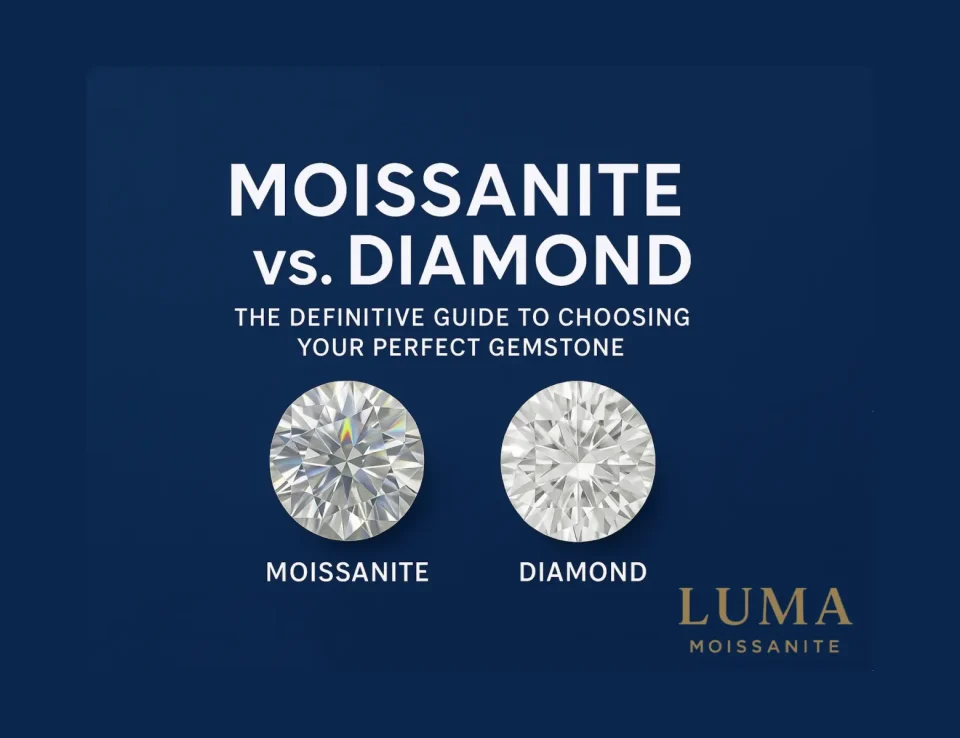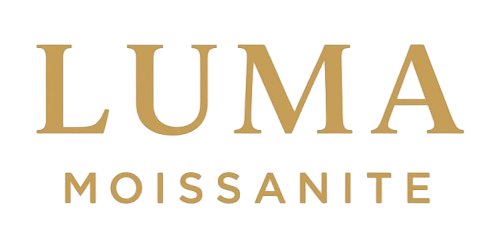
When you envision the perfect engagement ring or a timeless piece of fine jewelry, the image of a sparkling stone is likely at its center. For centuries, the diamond has been the undisputed king of gemstones. But today, a brilliant, ethical, and equally stunning alternative has emerged: Moissanite.
The debate of Moissanite vs. Diamond is one of the most important decisions for modern couples and jewelry enthusiasts. At Luma Moissanite, we believe in providing you with all the facts so you can make a choice that aligns with your values, style, and budget. This in-depth guide will explore the key differences—and surprising similarities—between these two breathtaking gems.
1. Brilliance and Fire: A Tale of Two Sparkles
The very first thing you notice about any gemstone is its sparkle. While both moissanite and diamonds are celebrated for their brilliance, they have distinct personalities when it comes to light performance.
Moissanite: Known for its “fiery” brilliance, moissanite has a higher refractive index (2.65-2.69) than diamond. This means it bends light more effectively, creating a mesmerizing display of rainbow flashes. This fiery, disco-ball-like sparkle is often what draws people to moissanite. If you desire a bold, vibrant, and multi-colored flash with every movement, moissanite is your clear winner. The intensity of moissanite fire is its signature trait, making it stand out from a distance.
Diamond: The diamond’s sparkle is often described as a classic “white” brilliance. Its light return is more focused, creating a beautiful contrast between bright white light (brilliance) and subtle colorful flashes (fire). Diamonds are prized for their elegant, understated sparkle. While less fiery than moissanite, a well-cut diamond has a sophisticated shimmer that has been the standard for centuries.
2. Durability and Hardness: A Gemstone for a Lifetime
An engagement ring is meant to be worn every day. Its gemstone must be durable enough to withstand the rigors of daily life.
Diamond: As the hardest known natural mineral, diamonds score a perfect 10 on the Mohs scale of hardness. This makes them incredibly resistant to scratches and abrasions, perfect for a lifetime of wear. Diamonds are the benchmark for durability in jewelry.
Moissanite: With a remarkable hardness of 9.25 on the Mohs scale, moissanite is one of the hardest gemstones used in jewelry, second only to diamond. This makes it an excellent choice for a moissanite engagement ring or any other piece of moissanite fine jewelry, as it is highly durable and resistant to scratching. You can confidently wear a moissanite ring without fear of it losing its sparkle.
3. Price and Value: The Ultimate in Accessible Luxury
This is often the most significant factor for many buyers. The cost of moissanite is a game-changer in the world of fine jewelry.
Diamond: Diamond prices are determined by the “4 C’s”: carat, cut, color, and clarity. As a naturally occurring and rare mineral, prices increase exponentially with size and quality. A 2-carat diamond of high quality can cost tens of thousands of dollars, making large stones inaccessible for many.
Moissanite: Moissanite is a lab-created gemstone, which allows for consistent quality and a significantly lower price point. You can purchase a large moissanite stone—often 2 to 3 times the size—for a fraction of the cost of a comparable diamond. This makes a stunning 3 carat moissanite engagement ring an attainable dream, rather than an extravagant luxury. This remarkable moissanite price vs diamond difference means you can get the same visual impact for a fraction of the cost.
4.Sustainability and Ethics: A Choice for a Better Future
For a growing number of consumers, the ethical and environmental impact of their purchases is a top priority.
Moissanite: The vast majority of moissanite is lab-created in a controlled environment. This process eliminates the environmental impact and ethical concerns associated with traditional mining. Choosing moissanite is a straightforward way to guarantee a conflict-free and eco-friendly gemstone. This commitment to sustainability is a core value of Luma Moissanite.
Diamond: While the diamond industry has made progress with ethical sourcing certifications, a significant portion of diamonds still come from traditional mining, which can have environmental and social consequences. For a guaranteed ethical stone, buyers must seek out lab-grown diamonds or ensure their natural diamond is certified as conflict-free.
5. Appearance to the Naked Eye: Can You Tell the Difference?
This is the question on everyone’s mind. The short answer? It’s extremely difficult for the average person to tell the difference.
Moissanite: To the untrained eye, moissanite looks virtually identical to a diamond. The primary visual difference is moissanite’s intense, rainbow-like fire, which may be more noticeable in direct sunlight or bright artificial light. While some may view this fire as too much, others find it to be the ultimate showstopper.
Diamond: Diamonds have a classic appearance that has been the standard for decades. Professionals use specialized tools to differentiate them from moissanite based on their chemical composition and optical properties. For most people, the difference in the moissanite vs diamond look is only apparent when the stones are side-by-side under specific lighting conditions.
Quick Comparison Table: Moissanite vs. Diamond
| Feature | Moissanite | Diamond |
| Brilliance | High, with fiery rainbow flashes | Classic white brilliance |
| Hardness | 9.25 (Excellent for everyday wear) | 10 (Highest known) |
| Price | Highly affordable, consistent pricing | Expensive, varies greatly with quality |
| Sourcing | Lab-grown, eco-friendly, and conflict-free | Often mined, but ethical options available |
| Appearance | Visually similar, with more intense sparkle | Classic, elegant, and timeless |
| Value | Significant value for money | Value holds due to rarity |
| Common Use | Moissanite Engagement Rings, Fine Jewelry | Traditional Engagement Rings, Fine Jewelry |
Which One Is Right for You?
Choosing between moissanite and diamond is a personal decision that should be based on what you value most.
Choose Moissanite if:
You want a large, brilliant stone without the high price tag.
You are an eco-conscious consumer and prioritize ethical, lab-grown gems.
You love a bold, fiery sparkle that makes a statement.
You are a modern couple looking for a luxurious yet sensible choice.
Choose Diamond if:
You value tradition and the timeless symbolism of a diamond.
You are a purist who desires the absolute hardest natural substance on earth.
You prefer a classic, understated white sparkle.
Why Buy From Luma Moissanite?
At Luma Moissanite, we specialize in crafting high-quality moissanite engagement rings, moissanite necklaces, moissanite earrings, and moissanite bracelets that are as stunning as they are affordable. We believe that everyone deserves to own beautiful, sparkling jewelry without compromise.
Our commitment to excellence means every moissanite stone is:
Certified: Every gem comes with a certificate of authenticity.
Ethically Sourced: Our lab-grown moissanite is guaranteed conflict-free.
Expertly Crafted: We use premium settings like 18K white gold, 18K rose gold, 18K yellow gold, and durable sterling silver (925) to ensure lasting beauty.
Whether you are in the USA, UK, Canada, Australia, or beyond, our worldwide shipping makes it easy to find your perfect moissanite jewelry online.
Conclusion
Both moissanite and diamonds are beautiful, durable, and brilliant choices for your fine jewelry. Ultimately, the best stone is the one that speaks to your heart and reflects your personal style. Explore our collections today and discover the brilliance of moissanite.
